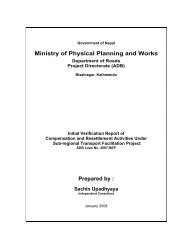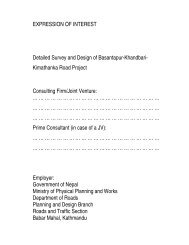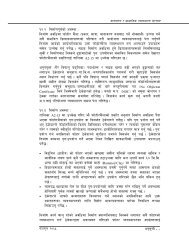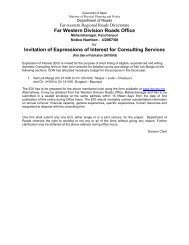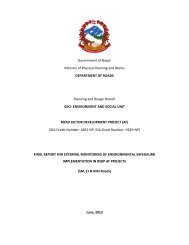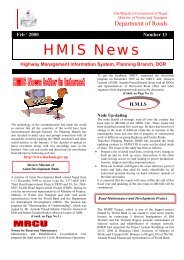Environmental & Social Management Framework - About ...
Environmental & Social Management Framework - About ...
Environmental & Social Management Framework - About ...
You also want an ePaper? Increase the reach of your titles
YUMPU automatically turns print PDFs into web optimized ePapers that Google loves.
<strong>Environmental</strong> and <strong>Social</strong> <strong>Management</strong> <strong>Framework</strong>Table 4.1: Opportunities and Risks from Road Construction Activities 2Sector Opportunities RisksLand Resettlement, rehabilitation andincrease in quality of lifeLandless, displacement, and decrease in qualityof lifeShelter Reconstruction of project acquired Homelessness and displacement, destitutionhouses, improved housing standardsEmployment Job opportunity Joblessness<strong>Social</strong> <strong>Social</strong> inclusion<strong>Social</strong> marginalization, destitution, conflictsChange<strong>Social</strong> Network and community linkage <strong>Social</strong> dysfunction and conflictsCohesionHealth Improved health care Increased morbidity and endemic diseases,spread of STDs, drugs, people traffickingNutrition Adequate nutrition Food insecurityCommonResourcesRestoration of community resourceassets and servicesLoss of access to common property resources,environmental hazards (irreversible, long-term)Education New or improved schoolopportunities for allChildren’s education restricted to wealthypeopleInfrastructure Rebuilding or strengthening Infrastructure failureCulturalHeritageSaving or re-siting cultural artefacts Heritage degradation or loss, cultural conflicts4.2 Beneficial ImpactsRoad Projects are generally intended to improve the economic and social welfareof people. The development efforts of the SRN Program, particularly thedevelopment of a strategic transportation network will have multifold beneficialimpacts. The majority of the communities receiving new and/or improved roadsbelieves that improved accessibility resulting from the project will improve theirstandard of living, give access to nearby markets and resources, education andhealth facilities. Unanimously the consulted communities are willing to provideassistance and to provide/donate voluntarily land for the RoW.The immediate beneficial impacts form road development become apparent inthe construction phase. Depending on the demographic and socio-economicsetting in a given location there will be various employment opportunities for thelocal population.During operation stage, an improved road access will bring in most if not alllocalities an improvement of food security situation, and will result in an overalleconomic and social stability. Increased road capacity and improved pavementsare expected to reduce travel times and lower the costs of vehicle use. At thesame time, good and reliable road links will increase access to markets, jobs,education, and health services and reducing transport costs for both freight andpassengers. In the long term, the road will provide safe and fast transport ofgoods and services from rural areas to urban centres and vice versa. This willbring about increase in productivity in rural areas and eventually improve theoverall socio-economic condition of people living in or nearby road corridors. At amore detailed level, the single benefit aspects are discussed hereunder andexpected to be detailed in the specific assessments in the forthcoming SRN subprojects.2 See also Reference Manual for <strong>Environmental</strong> and <strong>Social</strong> Aspects of Integrated RoadDevelopment, Road Maintenance and Development Project, Department of Roads / WorldBank, 2003Chapter 4-2 April 2007



![j:6 ]zg cfof ]hgf](https://img.yumpu.com/51286794/1/190x245/j6-zg-cfof-hgf.jpg?quality=85)

![x'nfsL /fhdfu { cfof ]hgf](https://img.yumpu.com/50581959/1/190x245/xnfsl-fhdfu-cfof-hgf.jpg?quality=85)
